Compilation of video footage, credits at Vimeo
Last week I spoke at Afrofuture, a series of events during Milan Design Week, about undersea cables, fiber optics, and the politics of light. The oddness of the venue means I’d like to give the talk again some time, but it also belongs alongside my previous writings on light (The dreadful luminosity of everything, Four Greens) and infrastructures (Secret Servers, GPS, Living inside the Machine), so I present it here, necessarily disjointed as a report of a lecture rather than a textborn essay. Thanks also to Jeremy Weate of Cassava Republic, for sharing his time and advice on the African broadband experience.
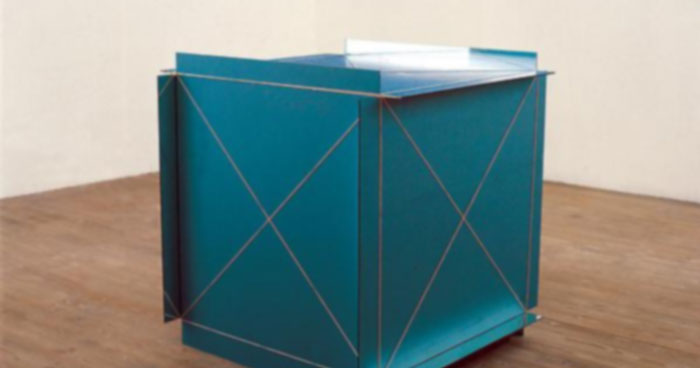
Michelangelo Pistoletto’s Metrocubo d’Infinito in un Cubo Specchiante (‘Square Metre of Infinity in a Mirror Cube’) is one of my favourite artworks in the world. It is as it describes: a one metre by one metre by one metre cube, formed of bound and inward-facing mirrors. There is something about this internal space that warps the mind: a cubic metre of infinity, a bounded space which no light can enter, but from which no light can escape, endlessly reflected, endlessly reproduced; a void, a chamber, an unseen, unknowable volume. It captures light, but repels inspection. It is an artefact worth attempting to hold in the mind, ultimately ungraspable, but always present.
![]()
If Pistoletto’s cube is a device for doing something interesting with light, it is one of many in humanity’s long history of communication and other technologies, of which beacons are among the first which might be considered networked. Scandinavian hill-forts, the Brecon Beacons, the coastlines of Elizabethan England and the Scottish Borders all played host to light-bearing networks, fires in the night, fires for warning and communicating. The Great Wall of China might be considered the first great light-based trunk line, a line of 723 beacons some 5,500 miles long. Beacons are also cited in the annals of shipwreckers, who were reputed to lure their targets onto shoals or beaches: dangerous, untrustworthy signals too.
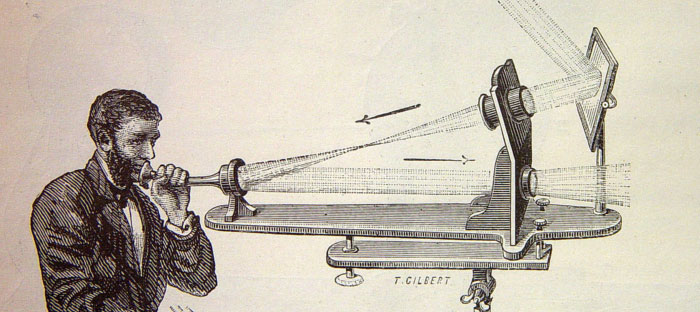
The first wireless telephone transmission was also transmitted by light, on June 30th 1880. Alexander Graham Bell, just four years after being granted his patent for the wired telephone, successfully transmitted the sound of a human voice 700 feet from the roof of the Franklin School in Washington, DC, to the window of Bell’s laboratory. The device Bell created with his assistance Charles Sumner Tainter was the photophone, and he believed it to be his most important invention.
The photophone works by bouncing a beam of sunlight off a reflecting surface, which is vibrated by the voice of the speaker, directed towards the back of the reflector. These vibrations can be picked up a photovoltaic cell, and amplified, in order to reproduce the spoken words.
For this lecture, I built a photophone with a hodgepodge of electronics, and the assistance of a Jameco tutorial, enclosed in African fabrics from Ridley Road market, and a transmitter built from tin foil and a hollowed-out coconut. It works – sort of. The transmitted words are not distinguishable, but there’s definitely a voice speaking amongst the crackling and hissing.
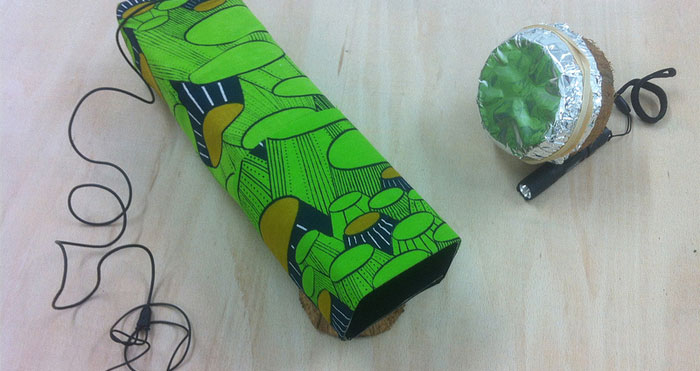
Bell was aware of the limitations of his device – the very clouds above interfered strongly with transmission – but also wondered at it, eulogising in a letter to his father:
I have heard articulate speech by sunlight! I have heard a ray of the sun laugh and cough and sing! …I have been able to hear a shadow and I have even perceived by ear the passage of a cloud across the sun’s disk.
Wider reception was slightly more circumspect. In an editorial of August 30, 1880,
the New York Times wrote:
The ordinary man … will find a little difficulty in comprehending how sunbeams are to be used. Does Prof. Bell intend to connect Boston and Cambridge … with a line of sunbeams hung on telegraph posts, and, if so, what diameter are the sunbeams to be ….[and] will it be necessary to insulate them against the weather … until (the public) sees a man going through the streets with a coil of No. 12 sunbeams on his shoulder, and suspending them from pole to pole, there will be a general feeling that there is something about Professor Bell’s photophone which places a tremendous strain on human credulity.
This image, of carrying a coil of sunbeams over one’s shoulder, and speaking through them, is a resonant and beautiful one, but also, brilliantly, it turns out to be entirely the case. Our contemporary fiber optic communications are a direct descendant of Bell’s invention. What was missing was a method for secure transport, the enclosure of the sunbeam in a series of tubes that might encircle the world.
While we are increasingly familiar with the forms of overland network infrastructures, such as datacenters, carrier hotels, switches, from personal computers and devices up to high-orbit satellites, the light-bearing cable network remains largely invisible to us, buried in the dirt and threaded beneath the oceans.
We can track these lines partially via the computers they connect, through the IP addresses revealed by traceroutes. For example, running a traceroute between my studio in London, and the Nigerian ISP Starcom in Lagos.
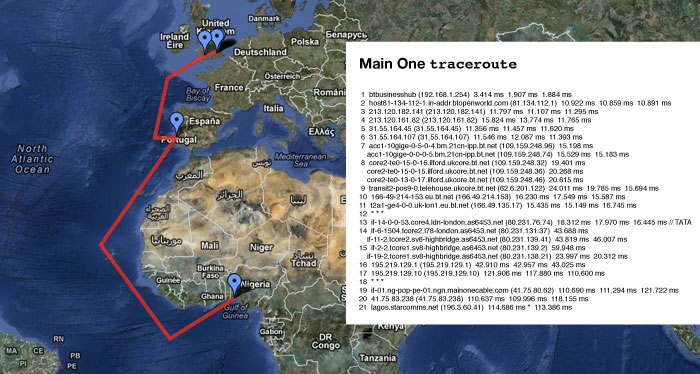
The series of IP addresses reveals a set of connections: from my local router, to BT exchanges in Chessington and Ilford, to the Telehouse complex back in East London again, out to Tata’s cable landing point a half mile from the sea in Highbridge, Somerset – and from there leaping first to Seixal in Portugal, another Tata facility, and then to Lagos, to a Main One Cable Landing Station and on to Starcom’s offices a few miles away.
(You can see all these locations on a Google Map – the most obscure location, that of the Main One CLS, I identified from a helpful engineer’s Foursquare checkin.)
It’s the last of these big jumps that’s the most interesting to me. The Main One cable was, at time of opening, the first African-owned cable bringing internet communications to the continent, a significant moment in national networking. The cable went live on July 22, 2010, connecting Seixal in Portugal, a major sea network hub, to Accra in Ghana and Lagos in Nigeria, and further connections to South Africa are planned.
Main One was followed by the GLO-1 system, owned by Nigerian telecommunications company Globacom, 9,800 km long with an advertised capacity of 2.5 Tbit/s, in 2011, also connecting Lagos and Ghana all the way back to the UK. Other complete or forthcoming Nigerian connections include SAT-3/WASC (2002), WACS (2012), ACE (2012) and WASACE (2015) (see submarinecablemap.com for details).

The Main One cable was laid by a ship called the Tyco Resolute, built in 2002, and one of a new generation of cable ships whose capacity, sensors and manoeuvrability permit ever more reliable and extensive undersea networks.
The process of laying cables across the ocean is a fascinating and venerable one, that proceeds in stages out into the deep ocean and back, ploughing trenches into the littoral to lay fragile cable under the sand in shallow areas, and paying it out across the deep seabed far from shore. These cables are fat bundles of optical fibers – millimetre-thick strands of glass, through which light is bounced all the way to its destination.
The most resonant moment comes when the ship reaches shore. When a cable-laying ship is a few hundred metres off shore, the last segment of cable is put on a small boat and brought to the beach. And there, thousands of miles from its origin, a man emerges from the ocean, carrying the internet over his shoulder. Sunbeams, indeed.
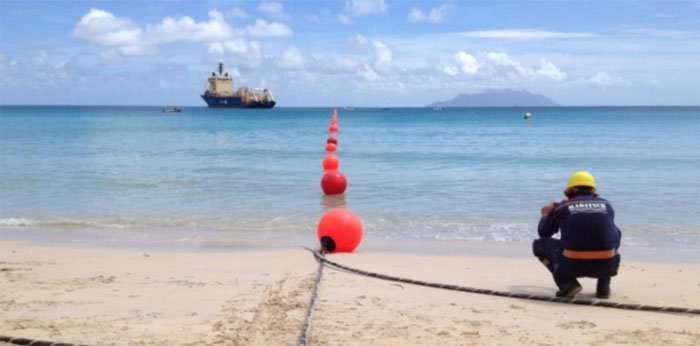
The impact of the arrival of true broadband communications are better covered elsewhere, but this is an impact driven by the arrival of these cables, these strands of light. Between 2008 and the end of 2011, according to studies by the World Bank and McKinsey, Nigeria’s online population alone went from 5% to 28% of the total – in a country with a population of 170 million. That’s 3.4 million, to 47.6 million internet users in four years.
Most of these users are concentrated in coastal cities close to the cable landing points: once the fibers reach land, their propagation – the backhaul – becomes the responsibility of the government, who control landbound infrastructures. The slow battle to upgrade these is in stark contrast to the sea, where private enterprise can do pretty much anything it likes, and does. In contrast to Nigeria, where residents complain about a lack of government investment in infrastructure, Kenya’s National Optic Fiber Backbone Infrastructure (NOFBI) is an ambitious plan to connect 36 administrative centres across the country, and from there to the population. A quiet war is building to be the internet heartland of Africa, and, so far, Kenya’s “Silicon Savannah” is making the most progress.
Other infrastructures are coming in to play too, including a microwave project by Main One to connect outlying areas of Lagos, and Nigeria’s National Space Research and Development Agency – the largest African space programme, which has put four satellites into orbit. The first of these failed, as satellites not infrequently do, but it was replaced in December 2011 by NigSatcCom-1R replaced it, broadcasting communications across the whole country. Two other satellites provide country-wide imaging, tracking crops and weather around the country in an effort to protect long-term food supply.

But the sea cables will remain the roots and taps of the internet in Africa and across the world, and they are subject to a number of different pressures.
The first of these is their own fragility. Resting on the seabed, they are subject to damage, malicious or otherwise. They are severed by dragging anchors or scrap hunters – only last week the Egyptian government arrested three divers off Alexandria who it accused of cutting a cable. The navy had been acting on information from Telecom Egypt which reported that the major SMW-4 undersea cable had been broken. Cables are rapidly approaching the status of protected national infrastructures, targets both of security, and potentially of violence.
But over and above these physical concerns, there are questions of ownership and control. Main One and GLO-1 are rare exceptions: most of Africa’s connecting infrastructure is owned by companies based elsewhere. The largest cables are owned by European and Indian telcos; in July 2012, it was announced that the Chinese government would be funding the construction of NOFBI. Nigeria’s satellites are built in Britain, and launched in China. One of the claims repeated in Globacom’s promotional videos: “We connect Nigeria to London, and from there to the world”.
The topography of the network is shaped by older, historical pressures, shipping routes and the networks of Empire. As Julian Oliver notes in an excellent lecture, in which he identifies the pattern of Spanish ownership in South American cable systems, colonialism has moved up from the physical, national space into the sphere of the corporate. As ever, tracing these physical infrastructures reveals the patterns of politics that support them.

And this should come as no surprise, because light itself is political. One of the great examples among many is the “Ancient Lights” law in the UK. In effect, the owner of a building with windows that have received natural daylight for 20 years or more is entitled to forbid any construction or other obstruction that would deprive him or her of that illumination. Once a right to light exists, the owner of the right is entitled to “sufficient light according to the ordinary notions of mankind”. Light is a privilege.
We see this privileged light through the lenses of many of our contemporary technologies, such as the air- and car-borne LIDAR scanners which build our contemporary cartographies. We see it in the one-way viewpoint of fixed and helicopter surveillance – and in the laser weapons deployed against them. Light takes on different qualities when perceived by machines.
But my favourite example of this privileged light brings together two of my frequent obsessions. First, the Light of God, as detailed in a previous post:
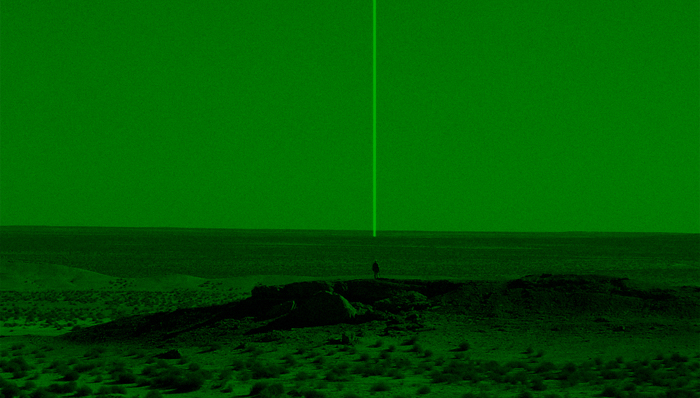
“We call it in, and we’re given all the clearances that are necessary, all the approvals and everything else, and then we do something called the Light of God – the Marines like to call it the Light of God. It’s a laser targetting marker. We just send out a beam of laser and when the troops put on their night vision goggles they’ll just see this light that looks like it’s coming from heaven. Right on the spot, coming out of nowhere, from the sky. It’s quite beautiful.”
That is a drone operator talking about targetting an IED site in Afghanistan or Iraq. It follows identification of the site by the operator using a thermal camera, and is immediately followed by a hellfire missile strike, watched by the operator as well as troops on the ground, and other military personnel in command centres, all the way up to the Pentagon. It’s a quote from Omer Fast’s extraordinary film “Five Thousand Feet is the Best” (2011, excerpt).
As I wrote then, I made the above image myself in photoshop, because I could not find one in the real world. And it took me some time to notice I had seen this same effect in action, before my own eyes – so to speak.

For the opening of the Shard, currently Europe’s tallest building, in July of last year, the people of London were promised an extraordinary spectacle, a light show of unprecedented power. I was among those gathered on the riverside, and like many I was disappointed by the flickering of a few weedy fingers of green light. But the following day, the papers were filled with startling, spectacular images, unrecognisable to those present, but captured by the long-exposure sensors of the press photographers’ cameras.
This was a spectacle designed not for human sight, but for technology: power speaking to power through the lens of a privileging technology, like the marines in the desert with their thousands of dollars of augmented vision.
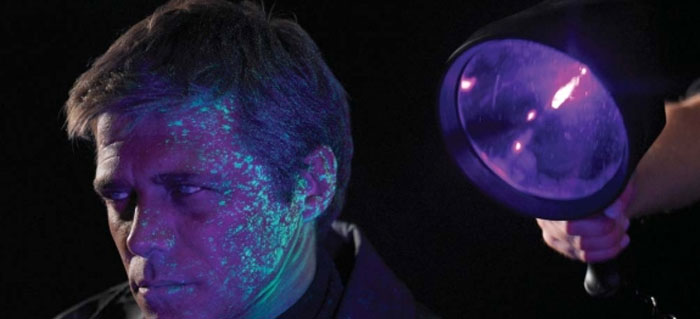
The channels of light outwith the spectrum of human vision are the domain of the machines, and of power. The infrared rings of CCTV cameras allow them to see our activities, criminal or otherwise, in darkness. At the other end of the rainbow, ultraviolet light reveals security markings on banknotes, and the mark of Cain on smartwater-splattered faces. (UV inks are specially controlled by law, unsurprisingly.)
For the lecture, I also constructed another coconut enclosure, this one filled with infrared LEDs. On the left, the object as the human eye perceives it, on the right, its image seen through the lens and screen of an iPhone: a simple device for showing the other spectra visible to (expensive) machines, an augmentation of privileged technology.
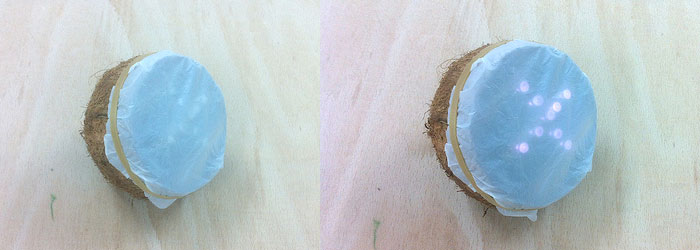
The photophone and the iPhone signaller are devices for communicating the transport and politics of light: they relate directly to the infrastructures of communication cables, made possible by Bell’s invention, but invisible to human sight, and charged with intent.
For me, the networks of fiber optics that encircle the planet evoke rich mythic resonances, but also reveal the politics and power relationships inherent and embedded in all of our contemporary technologies. Light itself, privileged and political, stands in for all of our invisble, noumenal technologies.
Pistoletto’s cube, light-bearing networks, lasers and scanners; all these uses, anglings and reflections of light, force us to ask questions about the light itself. What is light when it is information rather than illumination? What is it when it is not perceived by the human eye? Deep beneath the streets and oceans, what is illuminated by the machines, and how are we changed by this illumination?
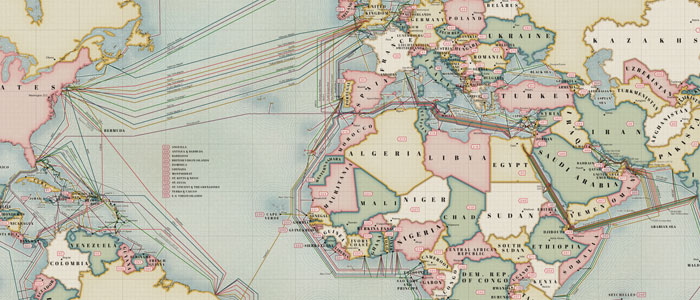
Comments are closed. Feel free to email if you have something to say, or leave a trackback from your own site.